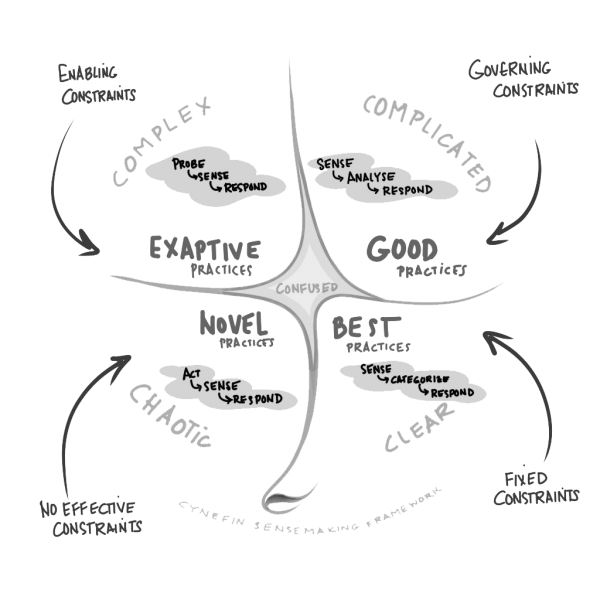Navigating conversations can be challenging, especially when the dynamics shift from simple exchanges to complex discussions. The Cynefin framework, originally designed for decision-making, offers a useful perspective on these communication challenges. By identifying the Cynefin domain we are conversing in, we can adjust our approach accordingly.
Introduction
The Cynefin framework, developed by Dave Snowden, offers a unique lens for analyzing and navigating different types of systems and decision-making contexts, ranging from simple to complex and chaotic environments.
While typically applied to organizational management, this model can also provide insights into the dynamics of human conversation. By viewing conversations as complex adaptive processes, we can use the Cynefin framework to understand better the nature of communication and how to navigate varying degrees of complexity and uncertainty.
The Five Cynefin Domains

The Cynefin framework comprises five domains: Clear (or Simple), Complicated, Complex, Chaotic, and Confused. Each domain represents a different relationship between cause and effect, requiring different approaches to decision-making and action. Let’s explore how these domains might manifest in a conversation:
“`html
Clear (Formerly Simple or Obvious) Domain
In the Clear domain of a conversation, the relationship between what is said and the appropriate response is straightforward and widely understood. There is little ambiguity, and participants can rely on established knowledge or common sense to communicate effectively.
Example: Asking for Directions
Imagine asking someone for directions to the nearest train station. The conversation follows a predictable pattern:
- Sense – You hear the question and recognize it as a request for factual information.
- Categorize – You identify that this is a straightforward, well-understood query with a standard response.
- Respond – You provide clear, direct instructions based on known best practices (e.g., “Walk two blocks straight, then turn left”).
In these conversations, there is little need for interpretation or debate. The focus is on providing clear, reliable information efficiently.
Complicated Domain
Conversations enter the Complicated domain when the subject requires expertise or analysis, but cause-and-effect relationships can still be determined with effort. Unlike the Clear domain, where the best response is obvious, a Complicated conversation involves thinking critically, drawing on specialized knowledge, and sometimes seeking expert input.
Example: Medical Diagnosis
Consider a conversation between a patient and a doctor about a persistent medical issue:
- Sense – The doctor listens to the patient’s symptoms and gathers relevant information.
- Analyze – The doctor considers possible causes, applies medical knowledge, and may run tests to determine the most likely diagnosis.
- Respond – Based on this analysis, the doctor provides a diagnosis and recommends treatment.
These conversations require logical thinking and expertise. While there may not be a single, immediate answer, applying the right knowledge and careful analysis leads to a solution.
Complex Domain
Many nuanced and multifaceted conversations reside in the Complex domain. Here, cause-and-effect relationships can only be identified in hindsight, not predicted in advance. The key to navigating these discussions is embracing uncertainty and adapting to emerging insights.
Example: Discussing the Future of Remote Work
Consider a discussion about the future of remote work:
- Probe – Participants share experiences, ideas, and potential challenges, without a clear-cut solution in mind.
- Sense – As different perspectives emerge, patterns and themes start to take shape.
- Respond – The conversation evolves based on new insights, and participants refine their understanding or adjust their positions accordingly.
These conversations benefit from open-ended exploration, active listening, and a willingness to adapt as new information or viewpoints arise. Rather than seeking an immediate answer, the goal is to uncover insights through discussion.
Chaotic Domain
Conversations enter the Chaotic domain during times of crisis, conflict, or extreme urgency, where there is no clear cause-and-effect relationship, and immediate action is needed to bring order.
Example: Crisis Communication
Imagine being in a burning building and someone shouts instructions on how to escape:
- Act – There is no time to analyze or debate; immediate action is required to ensure safety.
- Sense – After taking action, you quickly assess whether the situation is improving or if further action is needed.
- Respond – Based on the evolving situation, adjustments are made to regain stability (e.g., changing escape routes if one is blocked).
In these conversations, clarity and decisiveness are key. The priority is not discussion but rapid decision-making to establish order.
Confused (Formerly Disorder) Domain
The Confused domain represents moments when it is unclear which of the other domains applies. This often happens when participants in a conversation are uncertain, talking past each other, or lack enough information to determine the right approach.
Example: A Team Meeting with Unclear Direction
Imagine a team meeting where people disagree about the root cause of a recurring issue:
- Gather information – Ask clarifying questions and listen to different viewpoints to understand the nature of the conversation.
- Identify patterns – Determine whether the discussion is Clear, Complicated, Complex, or Chaotic.
- Reframe the conversation – Guide the discussion into the appropriate domain and adjust communication accordingly (e.g., shifting from confusion to analysis if the issue turns out to be Complicated).
The key in the Confused domain is recognizing the uncertainty and working to clarify the situation so the conversation can move forward productively.
As a conversation unfolds, it may shift between these domains. For example, what starts as a Clear exchange might evolve into a Complex discussion as new information or perspectives are introduced. Skilled communicators can recognize these shifts and adapt their approach accordingly. Understanding the Cynefin framework in conversations allows for greater flexibility, deeper engagement, and more effective communication in different contexts.
Understanding the Cynefin Framework in Conversations
Understanding the Cynefin framework in the context of conversation can help us:
- Recognize the nature of the discussion we’re engaged in.
- Adapt our communication style to suit the current domain.
- Navigate transitions between domains more effectively.
- Identify when additional information or expertise is needed.
- Manage expectations about outcomes and decision-making processes.
By viewing conversations through the Cynefin lens, we can develop a more nuanced understanding of communication dynamics. This awareness can lead to more effective, empathetic, and productive exchanges in personal relationships, professional settings, or public discourse.
The Cynefin framework offers a valuable tool for analyzing and navigating the complexities of human conversation. By recognizing the different domains and their characteristics, we can become more adept at managing diverse communication situations, leading to better understanding and more meaningful interactions.
POST NAVIGATION
CHAPTER NAVIGATION
SEARCH
Blook SearchGoogle Web Search
Photo Credits: Midjourney (Public Domain)
The Gurteen Knowledge Letter is a free monthly newsletter with over 20,000 subscribers that I have been publishing by email for over 20 years.
Learn more about the newsletter and register here.


Thinking about conversation through the lens of the Cynefin Framework was useful in decoding (understanding) a recent argument I had with a friend.
Hi Kirk, I am pleased to hear that. I am also writing a post looking at conversation more broadly through the lens of complexity. I find it novel way to look at things. Thanks, David